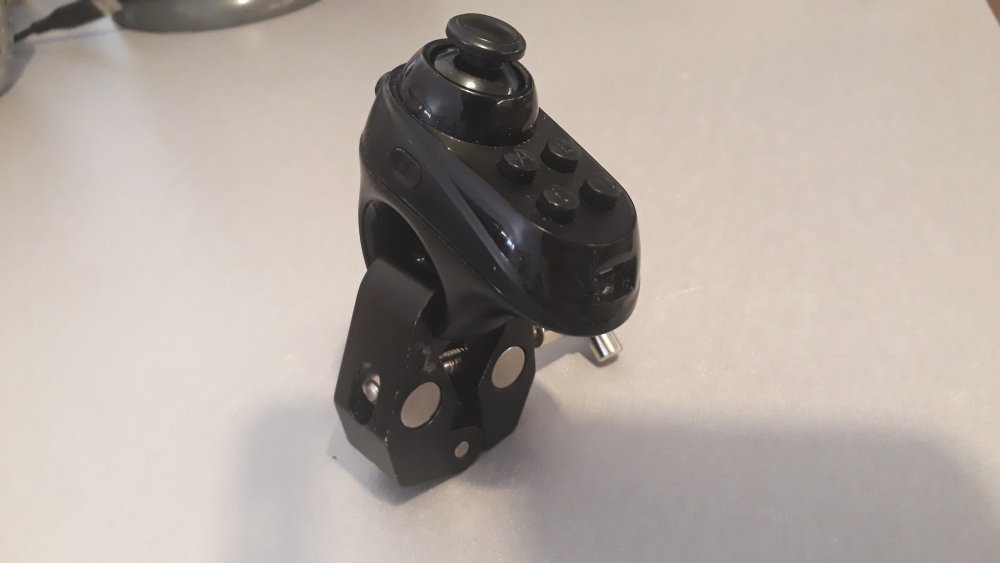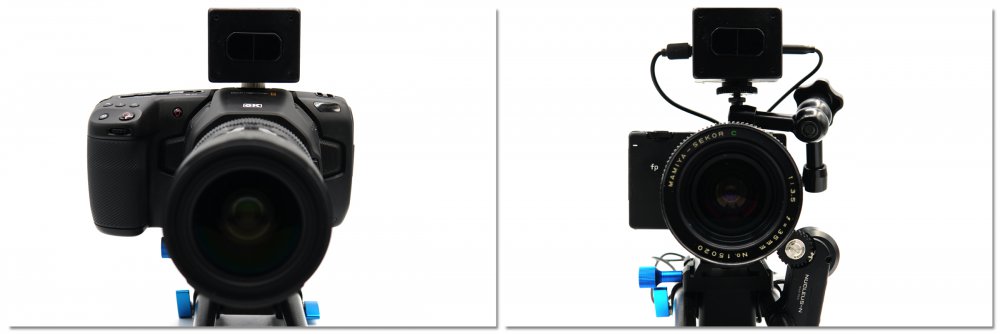-
Posts
5,964 -
Joined
-
Last visited
Content Type
Profiles
Forums
Articles
Everything posted by BTM_Pix
-
Optical Manouevres In The Dark https://www.eoshd.com/news/autofocus-in-the-dark-an-interview-with-cda-tek/#more-25140
-
Almost forgot, if you press the bottom trigger, while holding the stick to the right and double tap the C button you get a power up combo
-
No, as with the the electronic lenses on the P4K/6K, everything is done on the AFX itself with the controller. You tape a focus target on a wall (nothing fancy, anything contrasty will do so you can just put a piece of newspaper up if you want), focus the lens at minimum focus with the controller operating the focus movement, mark the point using the A button on the controller and this stores the focus point with its associated distance. Move back, re-focus, re-mark etc until you reach infinity and thats it done. Takes no more than 5-6 minutes per lens and only has to be done once as the calibration is stored on the AFX in its database and re-loaded when you put that lens on. In the case of the P4K/6K it is done automatically as it can read the lens name but for motor versions you just select it from a list. If you want to re-calibrate for any reason, you can pick the particular lens from the database in the setup menu, delete it and re-do it. As above, no app required as everything is mapped to buttons/joystick positions on the controller. Left Stick - Toggles between AF-S and AF-C Right Stick - Cycles through focus transition times for QuadLock Stick Up/Stick Down - Manual Focus (far/near) Top Trigger - Record Start/Stop (P4K/P6K Only) Bottom Trigger (Short Press) - AF ON/OFF (in AF-S mode re-triggers focus) Bottom Trigger (Long Press) - Engage/Disengage QuadLock focus target limiter A (Long Press ) Store current focus position in QuadLock Position A B (Long Press ) Store current focus position in QuadLock Position B C (Long Press ) Store current focus position in QuadLock Position C D (Long Press ) Store current focus position in QuadLock Position D A (Short Press) Move focus to QuadLock Position A (sets target to A if focus target limiter engaged) B (Short Press) Move focus to QuadLock Position B (sets target to B if focus target limiter engaged) C (Short Press) Move focus to QuadLock Position C (sets target to C if focus target limiter engaged) D (Short Press) Move focus to QuadLock Position D (sets target to A if focus target limiter engaged) In addition, the operation mode for buttons A,B,C,D can optionally be set to Command mode for P4K/6K where functions such as Aperture/ISO/WB etc can be mapped to them.
-
Thanks for your support. Have to play that one close to my chest for now. But it won't be far behind the AFX so the suspense won't last too long !
-
Yes, they will connect wirelessly. The AFX acts as the hub device controlling the camera (and lens motors for manual focus lenses) and receives/sends data to/from the additional components. An example of this that is built in already is the Tilta control wheel when using BMPCC4K/6K. It connects over BLE to the AFX and the AFX then translates its movements into controlling the native electronic lenses on the camera. This means that P4K/6K cameras can have the advantage of the more tactile control of a focus wheel without having to have focus motors and powering them etc. So in the same way, the additional module to offer AI based focus detection will process the data onboard and then pass that wirelessly to the AFX to action on the camera/lens motors.
-
It will auto focus to closest point in the central area. You control the switch between AF and manual modes with a trigger on the controller. So you can be manually focused and then press the trigger and it will engage the AF. In AF-S mode it will then not re-adjust until you press the trigger again so you can just use it to get and initial lock and then manually adjust from there or you can switch to AF-C mode where it will constantly re-focus on whatever is in the central area. The QuadLock system lets you set four different focus points in the scene either manually or using AF-S and then switch between them with adjustable transition time. QuadLock also has an additional function where you set one of the previously stored points as a target and then manually focus and it will automatically stop when you reach the target focus position ensuring that you do not overshoot. It will work with those cameras with manual focus lenses but it will obviously not do any of the camera parameter control and motorless operations that the BM cameras can use. The core AFX module does not support eye or body AF. But the next add on module for it does.
-
Yes it does. So if you have the Nano wheel you can also use it to set focus points for the QuadLock system etc. You can use one of these clamps like this and then that gives you the 1/4 20 thread so the ability to mount it on an arm etc etc A two pack of them with ball head adapters are £17 on Amazon and will give you a lot of flexibility and are just generally useful bits of kit. https://www.amazon.co.uk/2Pack-ChromLives-Camera-Clamp-Monitor/dp/B07GZ1D4BB
-
Its an option but would require an additional USB module for the AFX too. I'm not ruling that out (as it would suit other cameras too) but there a couple of other modules ahead of it in the development queue.
-
The issue with the FP is that the only way to control it is through the USB port which then, of course, stops you shooting to SSD So whilst we were keen to support the FP (as we love the camera) its likely going to be too much of a trade off for users to be a viable option. Thanks for your support.
-
Its a fixed internal rechargeable. It can be powered and simultaneously charged through USB.
-
Indeed it is. Pity I didn't know, you could have come down and had a demo !
-
-
Three days to go. The RAW shooting Sigma fp with the Baveyes 645 medium format speed booster is a little powerhouse. Particularly when you can now add ToF autofocus to that manual Mamiya 35mm lens.
-
If you want to tick every wide angle box for both cameras then Canon's full frame 11-24mm f4 L would certainly be the front runner. Unfortunately, even the used price of them means you'd also be ticking the box that said "please make me considerably poorer".
-
Yeah, the CinelikeD hack came out of me developing a couple of prototype controllers for Panasonic cameras before there was a pivot to the BM cameras. The PBC, and by extension the AFX, are actually built on that original foundation so if Panasonic introduce BLE control capabilities then its all there ready to go but using WiFi for control is not ideal (more in terms of power/heat with the cameras than the controller) so I'd prefer to avoid it.
-

EOSHD on The Golden Hour podcast with Dave Maze / In-depth interview
BTM_Pix replied to Andrew Reid's topic in Cameras
I can think of a couple of YouTubers that could be that third guest and you'd could probably then sell the PPV rights to Showtime. -
Unfortunately, the new one is slightly bigger so my favoured precision customisation method isn't applicable 😉
-
I know exactly how this feels. I went through a phase of suspecting that clicking on the buy button on any product on Amazon also triggered the press release for the release of the next version of it. With regard to this new version, I'm resisting it on the flimsiest excuse of the base of the body being a marginally different size so it won't be able to fit into my Z axis stabiliser. Of course, this stoic resistance to consumerism will likely dissolve as soon as the manufacturer of the Z axis makes a new version.
-
Logically, you'd think they'd put the R5 internals in the C70 style body, whack on an EVF and even double the price if they wanted to and serve up a powerhouse that still undercuts the Sony FX9 by 20%. Then you wake up and remember who's logic it is that we're dealing with.
-
I hesitated to go with that as I thought it was a bit niche !
-
<cough> €275 26/10/20 <cough> 😉
-
So would I if the hardware costs involved in providing real time AI face/object detection combined with 3D depth sensing allowed it.
-
Its dependent on the final hardware but based on the current prototype (as used in the unmasked face detection tracking video earlier in the thread) we would aim for a sub €200 price.
-
It won't be for another couple months after the AFX has shipped.
-
Thanks. It will work in portrait orientation (albeit with a narrower angle) so if you are putting the camera into portrait mode then there is no need to change it but we also recommend it to be in landscape mode because that is the way the info screen on the back is oriented. With regard to positioning, there is no limitation so you can put it in a hotshoe on the camera, or on top of a cage or a matte box or underneath the lens etc or even behind the camera if you want but obviously the only proviso is that you have it in the same position you had it when doing the initial calibration for the particular lens you are using. If it wasn't, then its not really a big deal as you can delete the calibration from the internal database and re-do it with the sensor in the new position. Calibration is a simple process and only takes minutes. As the AFX is battery powered and wireless (save for the small 3.5mm cable if you are using motors) then it is perfectly fine to use it handheld if you want, providing of course you respect the calibration issue. Handheld is an interesting use case actually as with the QuadLock function you can store up to four focus positions derived from either the sensor or manually (or any combination) and then either move to them automatically with differing dissolve times or have them as targets that you focus to manually without being able to overshoot. So using it handheld is a useful way to quickly capture the focus targets that you may use in a scene and you could even attach a small laser pointer to the top to give a visual reference while you are doing it. This is also possible when the AFX is mounted to the camera/rig of course, and would be the more common use case for solo shooters, but there are certain situations where it could be useful, most obviously with a separate person pulling focus. The other use case of course is for YouTube hosts to solve the "am I in focus?" conundrum because you can sit in front of the camera with it and fire it back at the camera to set the correct focus distance. Like an incident light meter but for focus 😉






